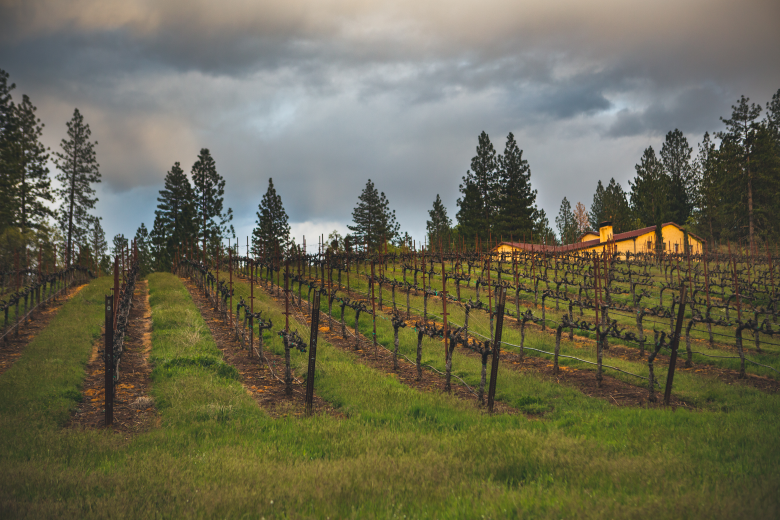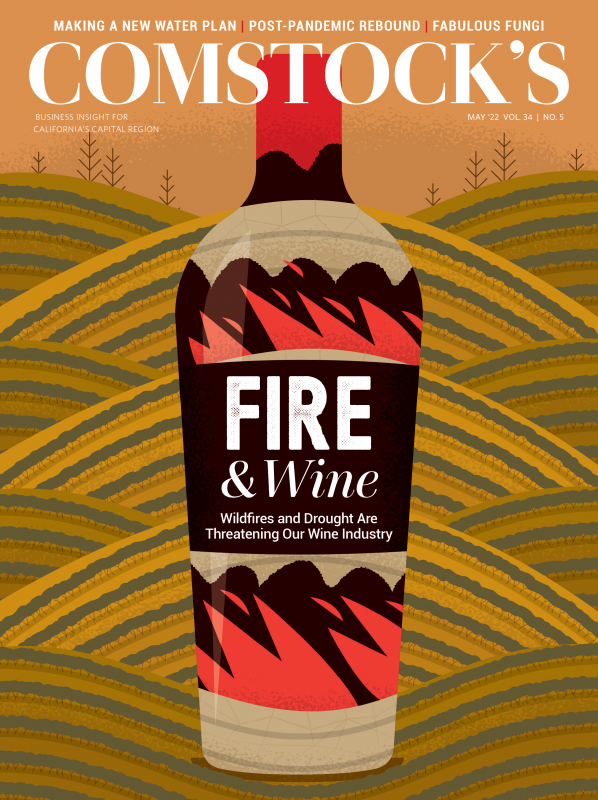A column of smoke lurched toward the vineyard like a mountain-shaped monster.
Last August, Miraflores Winery was one of five El Dorado County wineries suddenly in the path of a billowing volcanic spectacle that was invading Pleasant Valley. From its tasting room, one could see the broad trunk of ash expanding until distant trees were lost in a gray, dingy veil. The inferno was heading straight toward Miraflores, one of the most environmentally conscious wineries in the entire region.
For years it’s maintained wildlife friendly corridors and rodent control, as well as dedicated acres as fallow fields to buffer irrigation runoff from nearby streams. Miraflores also champions growing techniques that put nitrogen and nutrients back into the soil, a hallmark of regenerative farming. But on that August afternoon, one of the most dramatic embodiments of climate change was heading straight for its doors nonetheless — arriving in the raging, decimating form of the Caldor Fire.
The barren ground shows where fire crews bulldozed a fire break
to prevent the wildfire from advancing on the vineyards. (Photo
courtesy of Miraflores Winery)
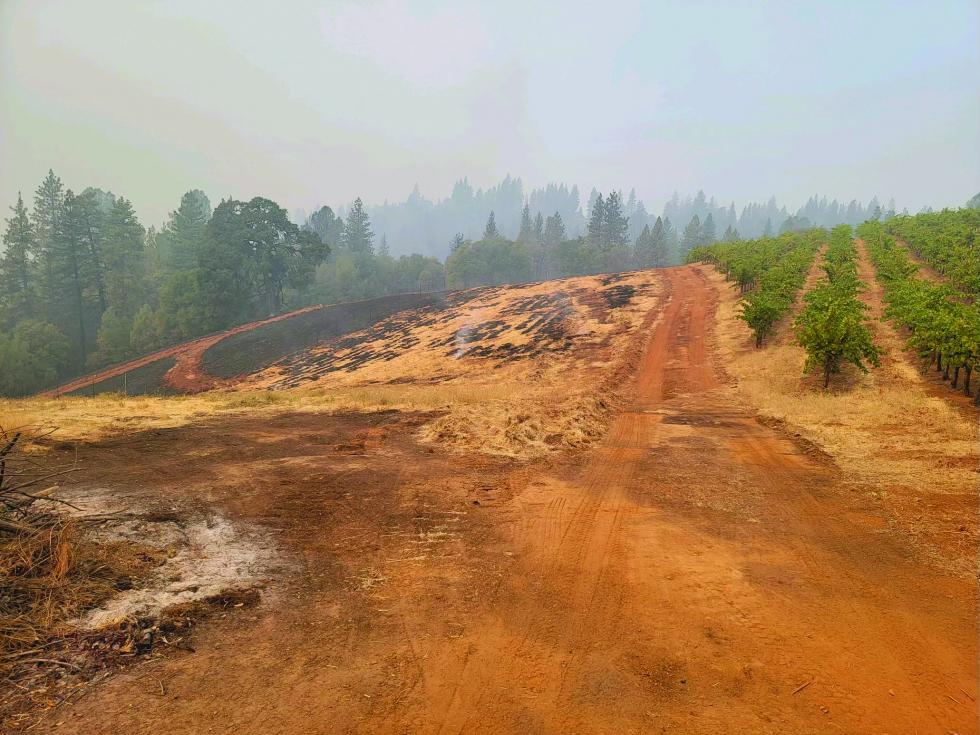
Marco Cappelli, consulting and former longtime winemaker at Miraflores, lives just a few miles from where the blaze first started. He woke at 4 a.m. because the vineyard’s harvest was coming in. He’d already been anxious about the grapes, but now his phone was flashing a dire warning that his entire family needed to evacuate.
“Dawn was just breaking, and I’d looked to the east where there was a fog bank sitting out there, but it wasn’t fog,” Cappelli remembers. “Looking out, you could see this black, tumultuous line of smoke. So I knew it was serious.”
In the end, Miraflores and the other wineries were saved from Caldor’s reach. Even after fire crews turned the blaze back, Cappelli and his colleagues were left with the bedeviling dilemma around potential smoke taint affecting the grapes in the vineyards.
Veteran winemaker Marco Cappelli, in the Miraflores Winery
tasting room, was one of several winemakers concerned about smoke
taint from the wildfires on the vines, which could negatively
affect the taste of the wine. (Photo by Wes Davis)
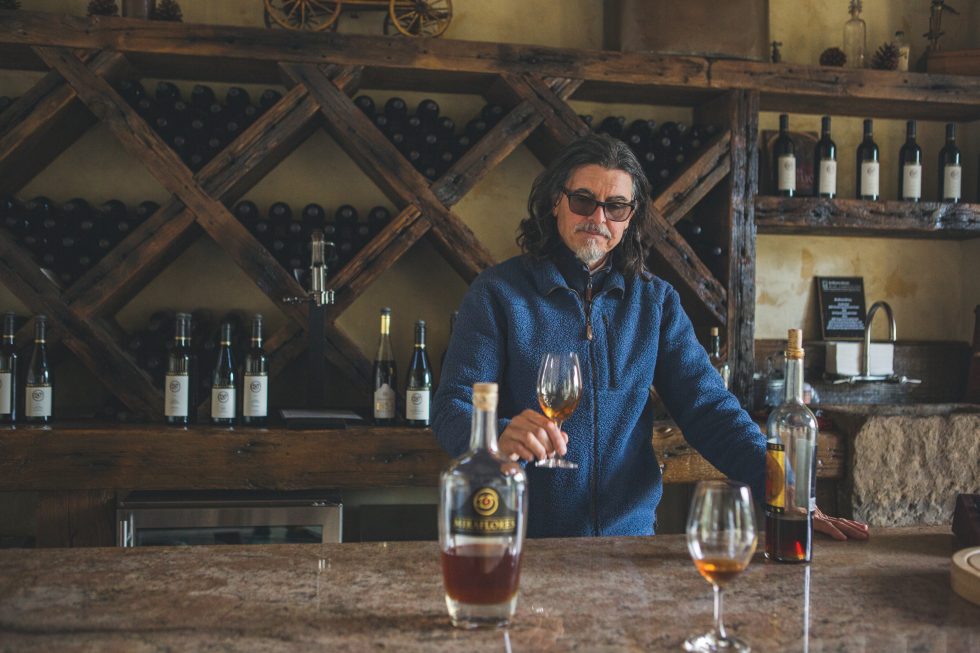
Wildfires signal perhaps the most immediate threat California’s $43 billion viticulture industry faces from a warming California. Yet they’re far from the only challenge. Wineries from the San Joaquin Valley to the Sierra Nevada foothills are all suffering from intensifying droughts and hot, almost endlessly dry seasons. Both problems are predicted to get worse in the coming decades.
For grape farmers, that could be devastating: The rainless skies of the last two years resulted in highly stressed crops and seriously diminished yields. Add to that the obstacle of getting fire insurance, and there has arguably never been a better time for winemakers to think about their relationship to the land — and their futures.
“Being that close to a fire the size of Caldor is frightening,” Cappelli says. “It’s just a force of nature that’s so powerful.”
Smoke gets in your eyes
Miraflores gained its following mostly through award-winning Rhône varietals and rare, high-elevation zinfandels. But it’s also found fame as a fun destination, hosting everything from Brunch and Bubbles get-togethers to wine and wild game pairings. When news broke that Miraflores might fall to the Caldor Fire, some wondered if all those experiences were ending.
The bulldozers and water trucks descending on Pleasant Valley made sure that didn’t happen. The flames eventually breached Miraflores’ property line, scorching 180 acres of its mountainous wildland and pine forest. But as the heat wave crept closer to the vineyards, firefighters managed to stop it. Miraculously, only a few rows of vines were lost.
Despite heavy smoke hanging on the grapes for a week, the team at Miraflores decided to try to salvage their harvest. Now, Cappelli and his fellow vintner Fernando Abarca are doing everything they can in the winemaking process to ensure no smoke taint — a flat, charred taste that deadens wine — makes it into the final bottles. Cappelli has some experience in this department, having worked with smoke-affected grapes in Calaveras County in the wake of 2015’s Butte Fire.
“The Bordeaux varietals seem to pick the taint up pretty quickly — the cab and the petite verdot,” he recalls of the damaged Calaveras grapes.
Zinfandel grapes from the same vineyards, Cappelli says, appeared resistant to the taint disaster. “It’s sort of a mercurial thing and we’re still learning more about it, as far as the timing, and the proximity to the fire and the varietal,” he says. “How bad of an issue we had from Caldor and whether it would render the wines unusable, I wasn’t sure.”
Miraflores is still engaged in chemical analysis of its grapes from the Caldor harvest. In the meantime, Cappelli and Abarca are hoping to mitigate the possible effects. That includes limiting the contact times between the grape skins and their juice while making rosé, as well as pressing earlier on their red wines and fermenting those in cooler conditions. But if Miraflores dodges a bullet on its 2021 yields, Cappelli won’t be downplaying how stressful the whole saga was. A nearby winery, Saluti Cellars, decided to abandon its entire crop for the year due to smoke taint.
“Because of our previous experience with how close a wildfire needs to be to impart a smokiness into the wines, I was never really that worried before. The Caldor Fire has changed that.” Marco Cappelli, consulting winemaker, Miraflores Winery
“Because of our previous experience with how close a wildfire needs to be to impart a smokiness into the wines, I was never really that worried before,” Cappelli says. “The Caldor Fire has changed that.”
All I need is the water
Sunlight stirred copper and gold colors through clusters of vines spilling down the hill as Bill Easton greeted 40 of his biggest fans. Easton is an award-winning winemaker who helped pioneer California’s Rhône Valley wine movement, pushing that vision from the rustic, rolling patchwork of Plymouth’s Shenandoah Valley. His success over 30 years with Terre Rouge and Easton Wines contributed to Amador County becoming one of the state’s most ascendent wine regions. On that bright, breezy morning, he was hosting an annual celebration of syrah, fittingly called Ascent.
But Easton isn’t just a master vintner, he’s also a conservationist who works with the Foothill Conservancy, a nonprofit dedicated to preserving and restoring the natural splendor of California’s Gold Country. For years the group has safeguarded native watersheds. Between Easton’s status as a longtime grape farmer, and his own involvement in natural resource protection, he’s become convinced climate change could trigger real hurdles for Amador County’s 49 wineries. The main reason, Easton stresses, is because most of them rely on groundwater to irrigate crops when the rains don’t come.
Easton was honest about this stress point with the wine lovers attending his Ascent tasting, noting the recent dry weather meant his grape yields shrunk by 50 percent. It’s his understanding this was the case for most Amador County vineyards, and the ones that were dry farmed or grown without irrigation and less than 20 inches of precipitation were down by as much as 60 percent.
A Cal Fire crew uses hand tools to break up the smoldering
remains of the wildfire. (Photo courtesy of Cal Fire)

“The farmers who were heavy waterers were maybe (down) by 30 percent, but the rest of us were off by a lot more,” Easton says. “The grape clusters really didn’t weigh a whole lot. And they didn’t have a lot of juice. … The trick this year was to get the grapes off the vine at the right time.”
As California’s droughts become more severe, the question of whether critically overdrafted groundwater basins can be recharged is haunting. Current climate modeling suggests groundwater will be the state’s main backup for dwindling surface water supplies from an ever fading snowpack in the Sierra. State officials are so worried about the calculus that in 2014 they passed the Sustainable Groundwater Management Act mandating the state achieve full groundwater sustainability by 2042. But eight years later, scientists and water agencies are still struggling to find a realistic roadmap to that goal.
Markus Niggli, a veteran winemaker within Lodi’s blooming grape basket, says complex water realities combined with rising temperatures could force major changes in what grapes are planted in San Joaquin County. Niggli’s label, Markus Wine Co., relies on several 80- and 90-year-old vineyards to produce his exquisite European-style vinos. These are deep-rooted vines that were dry farmed for generations, which means they can withstand hot, arid conditions.
However, when Niggli looks around Lodi, he sees some vineyards that are planted with grapes more suited to fluctuating market demands rather than genuine climate and soil conditions. That in turn makes them more water dependent. While Niggli thinks the zinfandel, carignan, cinsault, syrah and grenache that have been planted in Lodi since 1900 still make sense with the changing climate, he guesses San Joaquin’s vineyards that are over stocked with pinot noir and sauvignon blanc may end up struggling. He also thinks many of those vineyards are just too large to deal with elusive water supplies.
“It’s about crop control,” Niggli says. “I don’t need 20,000 acres. I’m good working with (4,000) or 5,000 acres. With less crop, you don’t need a gigantic canopy. So, it’s that — and having way harsher pruning. That controls where the plant pushes out. That’s key.”
Down to the river
On a bright afternoon, a father and his son stand casting their fishing lines into Steamboat Slough, its tide gliding under an old iron bridge where the Sacramento River meets a vein of the north Sacramento-San Joaquin River Delta. Just over the levee, cars begin pulling into the sunlit driveway of Grand Island Vineyards. Drivers catch a serene snapshot as they arrive. Down a channel from the tasting room, sun rays warm two stone lions guarding a mansion lost in this secret waterworld of pear orchards. North on the main riverway, a speedboat breaks the current as it passes a polished Broward yacht docked under a berm of oaks and wild oats. The visitors experiencing Grand Island’s rural hideaway get a barrel tasting from co-owner Joe Salman.
Salman is a third-generation delta farmer. His father was one of the key green thumbs in the 1970s who established the delta’s burgeoning wine appellation. The other farming families pivotal to that story, the Bogles and the Wilsons, all worked in the same direction toward the flat, channel-bound islands between Clarksburg and Grand Island, which were recognized for the best soil in the world for chenin blanc grapes. The delta’s petite syrah grapes are also showing the rest of California how its dynamic microclimate translates to greatness in the glass.
The Caldor Fire destroyed 1,003 buildings and threatened several
wineries in El Dorado County. Thanks to Cal Fire, no wineries
were lost. (Photo courtesy of Miraflores Winery)
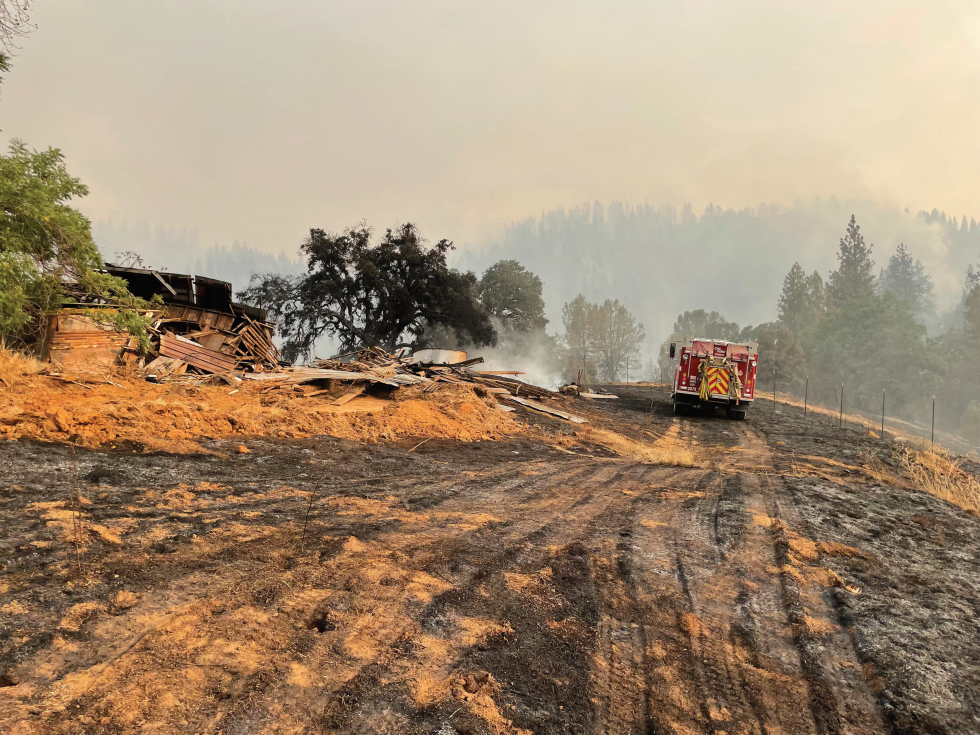
Like most farmers around Courtland, Salman has water rights to the fresh flow of the Sacramento River and its surrounding channels. Yet that blessing only helped to an extent during the extremely hot, dry year his vineyards just endured. Like his counterparts in Amador and El Dorado counties, Salman’s crops had unusually low yields. He says farmers with access to surface water can’t entirely substitute for seasonal moisture in the soil.
“Even with the irrigation pretty much functional, you’re kind of just keeping it going, but you’re still not getting the soil moisture that Mother Nature gives you on top of that,” Salman explained, noting his petite syrah and cabernet franc grapes were hit the hardest. “It really pulled those vines down so much,” he adds. “They had to keep ripening through the heat. When you just have nothing left in the soil, the vines just suffer.”
David Ogilvie, co-owner of Silt Wine Company in nearby Clarksburg, has seen the same effects on his crops, finding that surface irrigation can reach areas around the vines’ roots, while not fully reaching the broader root zone underground the same way seasonal rains would. “It’s an impact,” Ogilvie acknowledges. “You get good quality wine, but farmers have less grapes to sell.”
Cal Fire crews worked around the clock for three months to
contain the Caldor Fire. (Photo courtesy of Cal Fire)
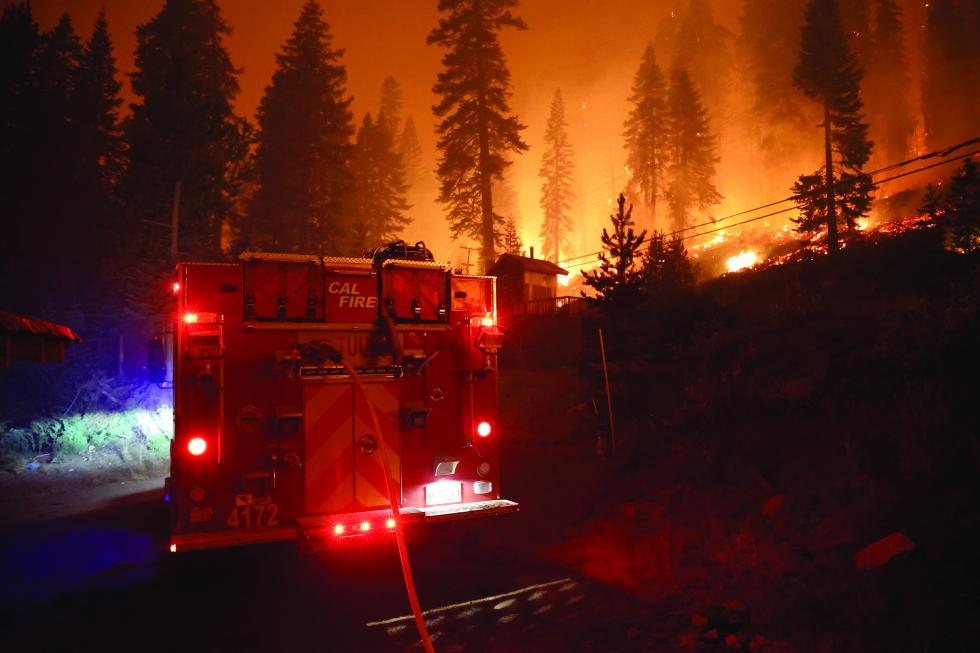
Ogilvie is part of the Wilson family.While he and Salman both stress their water rights to the Sacramento River put them in better shape than their counterparts in Lodi and the Sierra foothills, they’re also worried this advantage could be lost. For more than 14 years, the California Department of Water Resources has been seeking permission to build a massive tunnel that would divert huge amounts of fresh water out of the north delta and channel it to large central and southern state agribusinesses. Delta farmers and community members — and a number of independent scientists — fear this will quickly collapse the delta’s ecosystem and turn its lush maze of rivers into a bay-penetrated saltwater marsh. DWR is currently preparing a new environmental impact report on its proposed delta tunnel, after the last iteration of the project was scrapped by Gov. Gavin Newsom.
As climate change continues to exacerbate drought conditions year after year, Ogilvie, Salman and other delta winemakers are waiting to see if that spells mounting political pressure from Southern California interests to approve a tunnel that could be catastrophic to their home.
“There’s a reason this area has been so great for farming and risking all that doesn’t make sense from a sustainability standpoint,” Ogilvie says. “We don’t want to pit farmers in one part of the state against farmers in another, but I do think improving the state’s water storage capacity makes a whole lot more sense than jeopardizing this entire ecosystem.”
–
Stay up to date on business in the Capital Region: Subscribe to the Comstock’s newsletter today.
Recommended For You
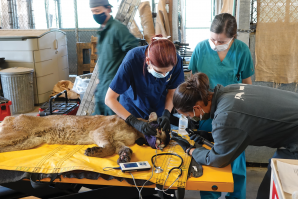
Saving Our Wildlife
When raging wildfires engulf our forests, what happens to the animals?
Capital Region researchers, veterinarians and advocates are
finding innovative ways to rehabilitate wildlife burned by
California’s raging wildfires.
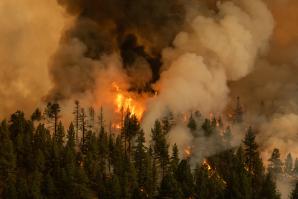
Earth, Wind and the Fire Next Time
Climate change is a factor in California’s rampaging wildfires, but not the only one
Due to human influence, three primary ingredients of wilderness fires are on the rise: the accumulation of biofuels in the forest, rising heat of the planet as a whole, and an ineffective political system of fire management.
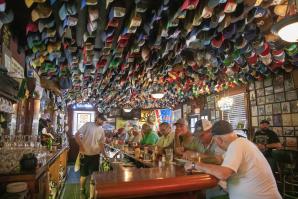
Remembering a Century of History at Giusti’s Place
On Sept. 9, the much-beloved Delta restaurant Giusti’s Place burned to the ground, taking a century’s worth of memories with it.
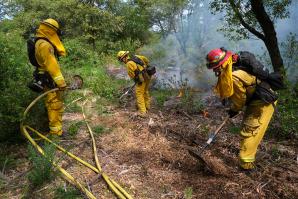
Beating the Burn
California’s plan to deal with deadly and devastating wildfires — including controlled burns, thinning and a restoration economy — is ambitious; is the state up to the task?
Past approaches to forest fires have been a misinformed regime of fire suppression: extinguishing all flames quickly. Now California’s forests are overgrown tinderboxes-in-waiting; the approach is changing, but there’s a lot of work to do.
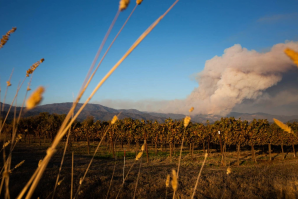
In California’s Wildfire Zones, Tales of Trauma and Resilience
Volunteers share their stories of bravery, resilience and trauma in the face of a growing wildfire threat in Northern California.



